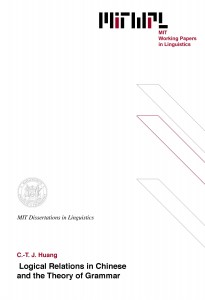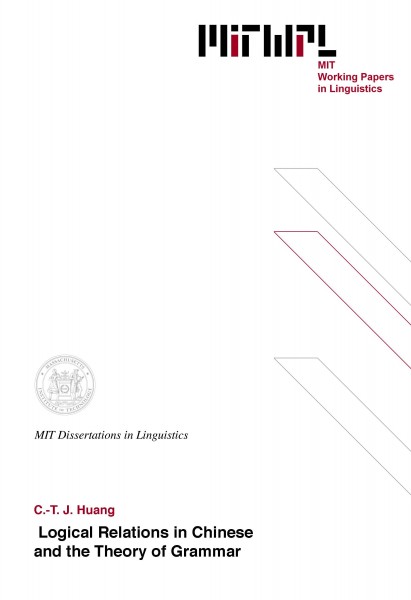Logical Relations in Chinese and the Theory of Grammar
C.-T. J. Huang, 1982
The nature of Logical Form is studied through an examination of the syntax and semantics of a range of constructions in Chinese that pertain to scope phenomena, anaphora, and the syntax of empty categories.
At a descriptive level, we provide an extensive account of Chinese quantificational sentences, wh questions, A-not-A questions and cleft sentences. Several aspects of anaphora are also discussed. At the theoretical level, we consider what the observed facts would mean for an optimal theory of Universal Grammar (UG) and linguistic typology.
An important intuition captured in traditional treatments of scope phenomena is that the surface order among quantifiers corresponds directly to their scope order in LF. A direct formulation of this idea is a principle of scope assignment, however, has been found to be insufficient in important respects. Certain recent accounts have now abandoned this idea, thus treating scope order of elements in simple sentences as essentially free. Consideration of na important typological distinction between Chinese and English, however, suggests that the more recent accounts are quite defective: while English exhibits scope ambiguity over a wide variety of construction types, Chinese does not. We propose to incorporate and modify the traditional idea as a principle of UG and explain the typological difference by the postulation of Restructure a, which applies freely in the construction types in question in English, but not in Chinese, due to an independent language-specific phrase structure principle.
A comparison of certain facts of anaphora in English and Chinese shows some problems with the binding theory. We propose a minimal modification of the notion of governing category. The “pro-drop” phenomenon in Chinese is examined, as well as certain facts concerning pronominal anaphora. Some similarities and differences between coreference and pronominal binding are also discussed.
The bounding theory embodying Subjacency and a condition on extraction domain is observed to obtain only in Syntax, not in LF. The Empty Category Principle (ECP) is shown to obtain both in SS and LF. Although Chinese lacks a full range of standard ECP effects, we argue on learnability grounds not to take the ECP as a parameter, but as a property of UG. This assumption is suppoted by our analysis of a range of data concerning an important argument/adjunct asymmetry under movement both at SS and at LF. Our account thus treats familiar subject/object asymmetries as but a special case of a more complement/non-complement asymmetry.
Thesis Supervisor: Kenneth Hale
Title: Ferrari P. Ward Professor
Table of Contents
Chapter 1 Overview 9
Chapter 2 Phrase Structures and the X’ Theory 25
2.0 Introduction 25
2.1 Basic structural patterns 26
2.2 Autonomous typology and X’ typology 32
2.3 Head-initial constructions 41
2.4 Head-final constructions 61
2.4.1 Noun phrases 61
2.4.2 Predicates 73
2.5 Quantifier phrases and supersentences 79
2.5.1 Quantifier phrases 79
2.5.2 Supersentences 83
2.5.2.1 Complementizers 83
2.5.2.2 Topic-comment and topicalized sentences 86
Footnotes 90
Chapter 3 Phrase Structures and Scope Relations 109
3.0 Introduction 109
3.1 Scope relations 110
3.2 Characterizing scope relations 124
3.2.1 Linear representations 124
3.2.2 Hierarchical representations 126
3.2.3 Comparing the two approaches 132
3.3 On the notion of configurationality 152
3.3.1 Scrambling and its correlates 152
3.3.2 “Flat” vs. configurational structures 155
3.3.3 A government theory of configurationality 159
3.3.4 The sentential structure of Chinese 166
Footnotes 173
Chapter 4 Some Mappings in LF 185
4.0 Introduction 185
4.1 Quantificational sentences 187
4.1.1 Sentences with Q-NPs contained in Other Q-NPs 187
4.1.1.1 Sentential scope and NP-internal scope 187
4.1.1.2 Two theories of NP-internal quantification 192
4.1.1.3 NP-internal scope and the syntactic nature
of LF 196
4.1.1.4 An account of the Chinese/English contrasts 202
4.1.2 Other quantificational sentences 235
4.2 Wh questions 251
4.2.1 Wh words as Q-NPs 251
4.2.2 Move Wh in Chinese 254
4.2.3 The wide scope property of wh words 263
4.3 Conjunction, disjunction and A-not-A questions 269
4.3.1 Conjunction 269
4.3.2 Disjunction 275
4.3.3 A-not-A questions 277
4.3.4 A note on non-objectual quantification 286
4.4 Cleft sentences 289
4.4.1 The construction 289
4.4.2 An LF account of clefts 292
4.4.3 On the analysis of SHI 299
Footnotes 307
Chapter 5 Anaphora and Binding 315
5.0 Intoduction 315
5.1 How the Binding Theory works 317
5.2 Some problems with the Binding Theory 323
5.3 A modification 336
5.4 On PRO in Chinese and the pro-drop parameter 348
5.4.1 The distribution PRO: some problems 348
5.4.2 The Pro-drop principle 365
5.5 On the non-coreference rule 377
5.5.1 Coreference and referential dependency 377
5.5.2 Pronoun anaphora in Chinese 388
5.6 Definite pronoun anaphora and pronominal binding 400
5.6.1 Some similarities 400
5.6.2 Some properties of pronominal binding 406
5.6.3 Why the properties of pronominal binding 426
Footnotes 439
Chapter 6 Move a, Subjacency and the ECP 450
6.0 Introduction 450
6.1 Subjacency 455
6.2 The Empty Category Principle 470
6.3 On Kayne’s ECP extensions 482
6.3.1 Kayne’s reformulation 482
6.3.2 Some problems with Kayne’s ECP 488
6.4 The condition on extraction domain 503
Footnotes 515
Chapter 7 Further Extensions of the ECP 524
7.0 Introduction 524
7.1 Some island effects in LF 525
7.2 A subjacency account 534
7.3 Inadequacies of the subjacency account 543
7.4 An ECP account 550
7.5 Problems solved 565
7.6 Some consequences 569
7.7 Some problems raised 574
Footnotes 581

